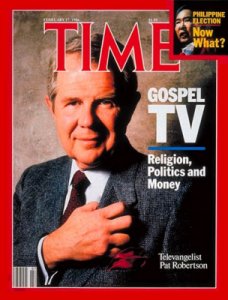
Experts Divided Aver Muslim Attacks' Impact on Religion
The Associated Press
12/15/01
Statistics seem to show that the terrorist attacks of September 11 has produced the big religious revival fundamentalists had hoped for-in fact the opposite. Will fundamentalists in both Virginia and Tennessee has tried to tear down the Wall of Separation that protects Americans from abusive religion, polls show no real increase in church attendance.
In a Sep. 21-22 Gallop poll showed 47% "said" they attended church in some form in the "last seven days" a "level not seen since the 1950s." But this is still means 53% since the 1950s don't regularly attend church. These religious polls are also notoriously inflated because many seemed embarrassed by saying no. There was a greater interest in church at the time, but another poll in November showed the level back to 42%, the same as other years. The revival was a dud.
The article goes on that a poll in November found only 16% of Americans attended church more frequently and said the reaction fits a pattern that during a time of crisis church attendance increased. What this doesn't say is non-church goers or those of alternate faiths showed up in any numbers. The jumps are temporary.
Yet churches claim the numbers are up, but lag far below the 50% marks for all three main religions of Christianity, Judaism, and Islam. The rest of the article goes on how Bible sales are up by 40% over last year. But to me they are going to those already in church and there have been claims about sending out Bibles as gifts to get people interested in church. It doesn't seen to have worked because alternate faiths and the ranks of the "unchurched" continue to grow. Coalition's Woe's May Hinder Goals of Christian Right New York Times, August 2, 1999 By Laurie Goodstein
The Christian Coalition, which for 10 years has led the charge of the religious right in national and local politics, is now weathering serious financial and leadership turmoil that could affect its ability to exert widespread influence in the 2000 election, current and former staff members say.
The coalition is hobbled by a $2.5 million debt, the departure of most of its experienced leaders, and so much turnover in local leadership that it currently has strong affiliates in no more than seven states, down from the 48 it claimed last year, the staff members say.
Read the full story at New York Times.
- Pat Robertson Introduction Page
- Pat Robertson Still Silly and Overblown by the Press
- Atheist Sues ACS claiming wrongful termination
- CitiGroup settles religious discrimination lawsuit
- Bakker: Asteroid will make Y2K look like Sunday picnic
- No casualties? White House disputes Robertson comment
- Pat's Big Lie
- Coalition Survival Questioned
- Racism at the Christian Coalition
- Experts Divided over Muslim Attacks' Impact on Religion
- Pat's Diamond Scam
- Pat Robertson Warns Dover Pa of Disaster
- Pat Robertson Attacks Hindus
- Pat Robertson Loses It in Attack on High Court
- How Pat Robertson - Virginia GOP Use Each Other
- Ten Years after Oklahoma City Bombing, Nothing
- Palast investigates Pat Robertson
- Pat Robertson - God tells me it's Bush in a blowout
- The Terrorist and the Televangelist: Charles Taylor and Pat Robertson
- Pat Robertson's High Horse
- Pat Robertson Describes Islam as Violent Religion
- Pat Robertson's Big Lie in Michigan
- Pat Robertson Nuke the State Department
- Robertson's Fierce Rhetoric Hurts His Political Clout
- Controversy at Calvary Chapel
- Premillennialism and John Nelson Darby
- Comments From a Former Fundamentalist
- East Tennessee Strip Bar Wars
- Challenge to Atheists 1
- Challenge to Atheists 2
- Challenge to Atheists 3
- Challenge to Atheists 4
- Challenge to Atheists 5
- Original Sin an Overview
- Gnosticism as Explained by Bishop N. T. Wright
- Deist Critique of the Gospel of Mark
- Religious Syncretism and Christianity
- Classical Deist' View of Religion and Its Application Today
- Taking a Closer Look at Gnosticism and Christianity
- Thoughts on Theistic Evolution and Deism by Lewis Loflin
- My Answer to a Secular Fundamentalist by Lewis Loflin